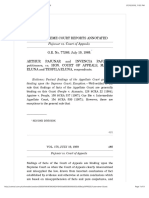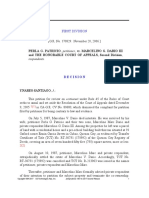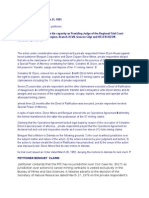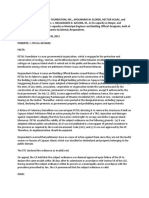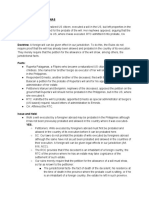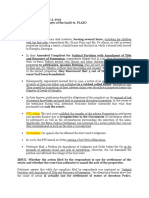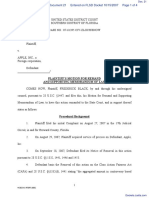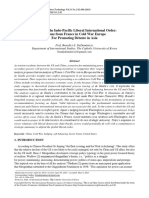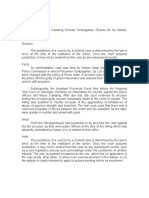0 ratings0% found this document useful (0 votes)
159 viewsDesamparado Vs CA
Desamparado Vs CA
Uploaded by
Irish GarciaThe document discusses a case regarding a land dispute over an area claimed to have been formed through accretion. It provides background on the legal requirements for accretion under Philippine law. The petitioners claimed the land was formed through the gradual deposition of soil from the river, while respondents argued it was the result of deliberate human intervention through dumping. Both the trial court and Court of Appeals dismissed the case, finding the Bureau of Lands had properly determined the land was artificially formed and part of the public domain, and that administrative remedies were exhausted. The Supreme Court upheld this decision, finding no grave abuse of discretion in the Bureau of Lands' handling and resolution of the issue.
Copyright:
© All Rights Reserved
Available Formats
Download as DOCX, PDF, TXT or read online from Scribd
Desamparado Vs CA
Desamparado Vs CA
Uploaded by
Irish Garcia0 ratings0% found this document useful (0 votes)
159 views4 pagesThe document discusses a case regarding a land dispute over an area claimed to have been formed through accretion. It provides background on the legal requirements for accretion under Philippine law. The petitioners claimed the land was formed through the gradual deposition of soil from the river, while respondents argued it was the result of deliberate human intervention through dumping. Both the trial court and Court of Appeals dismissed the case, finding the Bureau of Lands had properly determined the land was artificially formed and part of the public domain, and that administrative remedies were exhausted. The Supreme Court upheld this decision, finding no grave abuse of discretion in the Bureau of Lands' handling and resolution of the issue.
Original Description:
LAW
Original Title
Desamparado vs CA
Copyright
© © All Rights Reserved
Available Formats
DOCX, PDF, TXT or read online from Scribd
Share this document
Did you find this document useful?
Is this content inappropriate?
The document discusses a case regarding a land dispute over an area claimed to have been formed through accretion. It provides background on the legal requirements for accretion under Philippine law. The petitioners claimed the land was formed through the gradual deposition of soil from the river, while respondents argued it was the result of deliberate human intervention through dumping. Both the trial court and Court of Appeals dismissed the case, finding the Bureau of Lands had properly determined the land was artificially formed and part of the public domain, and that administrative remedies were exhausted. The Supreme Court upheld this decision, finding no grave abuse of discretion in the Bureau of Lands' handling and resolution of the issue.
Copyright:
© All Rights Reserved
Available Formats
Download as DOCX, PDF, TXT or read online from Scribd
Download as docx, pdf, or txt
0 ratings0% found this document useful (0 votes)
159 views4 pagesDesamparado Vs CA
Desamparado Vs CA
Uploaded by
Irish GarciaThe document discusses a case regarding a land dispute over an area claimed to have been formed through accretion. It provides background on the legal requirements for accretion under Philippine law. The petitioners claimed the land was formed through the gradual deposition of soil from the river, while respondents argued it was the result of deliberate human intervention through dumping. Both the trial court and Court of Appeals dismissed the case, finding the Bureau of Lands had properly determined the land was artificially formed and part of the public domain, and that administrative remedies were exhausted. The Supreme Court upheld this decision, finding no grave abuse of discretion in the Bureau of Lands' handling and resolution of the issue.
Copyright:
© All Rights Reserved
Available Formats
Download as DOCX, PDF, TXT or read online from Scribd
Download as docx, pdf, or txt
You are on page 1of 4
DESAMPARADO VDA DE NAZARENO VS. COURT OF APPEALS, 257 SCRA 589, G.R. No.
98045 June 26, 1996
TOPIC: ACCRETION
eSCRA:
Public Lands; Property; Accretion; Requisites of Accretion.In the case of Meneses v.
CA, this Court held that accretion, as a mode of acquiring property under Art. 457 of
the Civil Code, requires the concurrence of these requisites: (1) that the deposition
of soil or sediment be gradual and imperceptible; (2) that it be the result of the
action of the waters of the river (or sea); and (3) that the land where accretion takes
place is adjacent to the banks of rivers (or the sea coast). These are called the rules
on alluvion which if present in a case, give to the owners of lands adjoining the
banks of rivers or streams any accretion gradually received from the effects of the
current of waters.
Same; Same; Same; Words and Phrases; Claimants, not having met the first and
second requirements of the rules on alluvion, cannot claim the rights of riparian
owner.In Hilario v. City of Manila, this Court held that the word current indicates
the participation of the body of water in the ebb and flow of waters due to high and
low tide. Petitioners submission not having met the first and second requirements
of the rules on alluvion, they cannot claim the rights of a riparian owner.
Administrative Law; When findings of administrative agencies are accorded not only
respect but finality.This Court has often enough held that findings of
administrative agencies which have acquired expertise because their jurisdiction is
confined to specific matters are generally accorded not only respect but even
finality. Again, when said factual findings are affirmed by the Court of Appeals, the
same are conclusive on the parties and not reviewable by this Court.
Public Lands; Property; Accretion; The requirement that the deposit should be due to
the effect of the current of the river is indispensable.In Republic v. CA, this Court
ruled that the requirement that the deposit should be due to the effect of the
current of the river is indispensable. This excludes from Art. 457 of the Civil Code all
deposits caused by human intervention. Putting it differently, alluvion must be the
exclusive work of nature. Thus, in Tiongco v. Director of Lands, et al., where the land
was not formed solely by the natural effect of the water current of the river
bordering said land but is also the consequence of the direct and deliberate
intervention of man, it was deemed a man-made accretion and, as such, part of the
public domain.
Same; Same; Same; The dumping of boulders, soil and other filling materials into
the creek and river bounding the land, the same would still be part of the public
domain.In the case at bar, the subject land was the direct result of the dumping of
sawdust by the Sun Valley Lumber Co. consequent to its sawmill operations. Even if
this Court were to take into consideration petitioners submission that the accretion
site was the result of the late Antonio Nazarenos labor consisting in the dumping of
boulders, soil and other filling materials into the Balacanas Creek and Cagayan
River bounding his land, the same would still be part of the public domain.
Same; Same; Same; Jurisdiction; When Bureau of Lands and Office of the Secretary
of Agriculture and Natural Resources have jurisdiction over the land.Having
determined that the subject land is public land, a fortiori, the Bureau of Lands, as
well as the Office of the Secretary of Agriculture and Natural Resources have
jurisdiction over the same in accordance with the Public Land Law. Accordingly, the
court a quo dismissed petitioners complaint for non-exhaustion of administrative
remedies which ruling the Court of Appeals affirmed.
Administrative Law; Exhaustion of Administrative Remedies; When administrative
remedies have been exhausted.However, this Court agrees with petitioners that
administrative remedies have been exhausted. Petitioners could not have intended
to appeal to respondent Ignacio as an Officer-In-Charge of the Bureau of Lands. The
decision being appealed from was the decision of respondent Hilario who was the
Regional Director of the Bureau of Lands. Said decision was made for and by
authority of the Director of Lands. It would be incongruous to appeal the decision
of the Regional Director of the Bureau of Lands acting for the Director of the Bureau
of Lands to an Officer-In-Charge of the Bureau of Lands.
Same; Same; When the Undersecretary of Agriculture and Natural Resources may
modify, adopt, or set aside the orders or decisions of Director of Lands.In any
case, respondent Rolleo Ignacios official designation was Undersecretary of the
Department of Agriculture and Natural Resources. He was only an Officer-In-
Charge of the Bureau of Lands. When he acted on the late Antonio Nazarenos
motion for reconsideration by affirming or adopting respondent Hilarios decision, he
was acting on said motion as an Undersecretary on behalf of the Secretary of the
Department. In the case of Hamoy v. Secretary of Agriculture and Natural
Resources, this Court held that the Undersecretary of Agriculture and Natural
Resources may modify, adopt, or set aside the orders or decisions of the Director of
Lands with respect to questions involving public lands under the administration and
control of the Bureau of Lands and the Department of Agriculture and Natural
Resources. He cannot, therefore, be said to have acted beyond the bounds of his
jurisdiction under Sections 3, 4 and 5 of Commonwealth Act No. 141.
Public Lands; Property; Accretion; Jurisdiction; When Director of Lands has
jurisdiction over the land.As borne out by the administrative findings, the
controverted land is public land, being an artificial accretion of sawdust. As such,
the Director of Lands has jurisdiction, authority and control over the same, as
mandated under Sections 3 and 4 of the Public Land Law (C.A. No. 141) which
states, thus: Sec. 3. The Secretary of Agriculture and Natural Resources shall be
the exclusive officer charged with carrying out the provisions of this Act through the
Director of Lands who shall act under his immediate control. Sec. 4. Subject to said
control, the Director of Lands shall have direct executive control of the survey,
classification, lease, sale or any other form of concession or disposition and
management of the lands of the public domain, and his decisions as to questions of
fact shall be conclusive when approved by the Secretary of Agriculture and Natural
Resources.
Same; Same; When the execution of the order was issued not arbitrarily and
capricious.In connection with the second issue, petitioners ascribe whim,
arbitrariness or capriciousness in the execution order of public respondent Abelardo
G. Palad, the Director of Lands. This Court finds otherwise since said decision was
based on the conclusive finding that the subject land was public land. Thus, this
Court agrees with the Court of Appeals that the Director of Lands acted within his
rights when he issued the assailed execution order, as mandated by the aforecited
provisions.
Same; Same; When Director of Lands is authorized to exercise executive control of
public domain.As Director of Lands, respondent Palad is authorized to exercise
executive control over any form of concession, disposition and management of the
lands of the public domain. He may issue decisions and orders as he may see fit
under the circumstances as long as they are based on the findings of fact.
Same; Same; When Director of Lands acts within his jurisdiction in disposing public
lands.In the case of Calibo v. Ballesteros, this Court held that where, in the
disposition of public lands, the Director of Lands bases his decision on the evidence
thus presented, he clearly acts within his jurisdiction, and if he errs in appraising the
evidence, the error is one of judgment, but not an act of grave abuse of discretion
annullable by certiorari. Thus, except for the issue of non-exhaustion of
administrative remedies, this Court finds no reversible error nor grave abuse of
discretion in the decision of the Court of Appeals. Vda. de Nazareno vs. Court of
Appeals, 257 SCRA 589, G.R. No. 98045 June 26, 1996
Facts:
Sometimes in 1979, PR Salasalan and Rabaya leased the subject lots on which their
houses stood from one Antonio Nazareno, petitioners predecessor-in-interest. In the
latter part of 1982, PR allegedly stopped paying rentals. As a result, petitioners filed
a case for ejectment with the MTC of CDO. A decision was rendered against PR,
which decision was affirmed by the RTC of Misamis Oriental, before he died, Antonio
Nazareno caused the approval by the Bureau of Lands of the Survey plan with a
view of perfecting his title over the accretion are being claimed by him. Before the
approved survey plan could be released to the applicant, however it was protested
by PR before the Bureau of Land. Upon investigating of the RD of Bureau of Land, it
was recommended that Survey Plan in the name of Antonio Nazareno who denied
the motion, Respondent Director of Land then ordered him to vacate the portion
adjudicated to private respondent be placed in possession thereof. Upon the denial
of the late Antonio Nazareno's motion for reconsideration, petitioners Desamparado
Vda. de Nazareno and Leticia Tapia Nazareno, filed a case before the RTC, Branch22
for annulment of the following: order of investigation by respondent Gillera,
report and recommendation by respondent Labis, decision by respondent Hilario,
order by respondent Ignacio affirming the decision of respondent Hilario and order
of execution by respondent Palad. The RTC dismissed the complaint for failure to
exhaust administrative remedies which resulted in the finality of the administrative
decision of the Bureau of Lands, On Appeal, the CA affirmed the decision of the RTC
dismissing the complaint
Issue: W/N the subject land is public land.
Ruling:
Petitioners claim that the subject land is private land being an accretion to his titled
property, applying Art. 457 of the Civil Code which provides: To the owner of lands
adjoining the banks of river belong the accretion which they gradually receive from
the effect of the current of the water. In the case of Meneses v. CA, this Court held
that accretion, as a mode of acquiring property under Art. 457 of the Civil Code,
requires the concurrence of these requisites.
a. That the deposition of soil or sediment be gradual and imperceptible;
b. That it be the result of the action of the waters of the river (or sea);
c. That the land where takes place is adjacent to the bank of river (or the sea cost).
These are called the rules on alluvion which if present in a case, give to the owner
of lands adjoining the bank of rivers or stream any accretion gradually received
from the effect of the current of waters. Furthermore, the Bureau of Lands, classified
the subject land as an accretion are which was formed by
deposits of sawdust in Balacanas Creek and the Cagayan river, in accordance with
the ocular inspection conducted by the Bureau of Land.
You might also like
- Report of SWP's Disputes CommitteeDocument22 pagesReport of SWP's Disputes CommitteeernestobulNo ratings yet
- Pajunar VS CaDocument9 pagesPajunar VS CaKGTorresNo ratings yet
- Kepco Vs CirDocument1 pageKepco Vs CirMatthew ChandlerNo ratings yet
- Sps Cha Vs CaDocument4 pagesSps Cha Vs Caapi-263595583No ratings yet
- 29 Aguirre Vs PhengDocument5 pages29 Aguirre Vs PhengVianice BaroroNo ratings yet
- GR No. 170829 - Patricio Vs Dario IIIDocument13 pagesGR No. 170829 - Patricio Vs Dario IIIJobi BryantNo ratings yet
- STANLEY FINE FURNITURE G.R. No.190486 November 26, 2014Document1 pageSTANLEY FINE FURNITURE G.R. No.190486 November 26, 2014Melvin Ikko EspornaNo ratings yet
- Sombilon V GarayDocument9 pagesSombilon V GarayMars MarsseNo ratings yet
- Republic V. Verzosa: Johan Constitutional Law 1Document2 pagesRepublic V. Verzosa: Johan Constitutional Law 1Gedan TanNo ratings yet
- LEONILA G. SANTIAGO, Petitioner, vs. Peopleof The Philippines, RespondentDocument7 pagesLEONILA G. SANTIAGO, Petitioner, vs. Peopleof The Philippines, RespondentKristelle IgnacioNo ratings yet
- Imperial Textile Mills v. SampangDocument4 pagesImperial Textile Mills v. SampangDNAANo ratings yet
- Isabela Colleges Vs Heirs of Nieves Tolentino-RiveraDocument10 pagesIsabela Colleges Vs Heirs of Nieves Tolentino-RiveraMabelle ArellanoNo ratings yet
- Envi Law CasesDocument8 pagesEnvi Law CasesLeiBautistaNo ratings yet
- Spouses Lopez Vs Spouses LopezDocument8 pagesSpouses Lopez Vs Spouses Lopezecinue guirreisaNo ratings yet
- Acaac V AzcunaDocument2 pagesAcaac V AzcunaDrexel Arginald AltavanoNo ratings yet
- Republic v. Northern CementDocument5 pagesRepublic v. Northern Cementkrizea100% (1)
- ESSO Standard Eastern v. LimDocument10 pagesESSO Standard Eastern v. LimMaria AnalynNo ratings yet
- Eastern Telecom Inc Vs CIR GR 183531Document2 pagesEastern Telecom Inc Vs CIR GR 183531Timothy Joel CabreraNo ratings yet
- Municipal Rural Bank of Libmanan VsDocument1 pageMunicipal Rural Bank of Libmanan VsIñigo Mathay RojasNo ratings yet
- Arriola VsDocument2 pagesArriola VsEly Belle LingbawanNo ratings yet
- Gabriel VS CaDocument2 pagesGabriel VS CatrextanNo ratings yet
- Arturo Sarte Flores Vs SPOUSES ENRICO L. LINDO, JR. and EDNA C. LINDODocument6 pagesArturo Sarte Flores Vs SPOUSES ENRICO L. LINDO, JR. and EDNA C. LINDOKay AvilesNo ratings yet
- 10 Manufacturers Hanover Trust Vs GuerreroDocument157 pages10 Manufacturers Hanover Trust Vs GuerreroChara GalaNo ratings yet
- Lorenzo v. Director of HealthDocument1 pageLorenzo v. Director of HealthYeyen M. EvoraNo ratings yet
- 3.) GSIS v. Jum AngelDocument2 pages3.) GSIS v. Jum AngelJarvin David ResusNo ratings yet
- Matron M. Ohama v. Office of The Muicipal Local Civil Registrar of Aguinaldo, Ifugao & The Republic of The PhilippinesDocument7 pagesMatron M. Ohama v. Office of The Muicipal Local Civil Registrar of Aguinaldo, Ifugao & The Republic of The PhilippinesMaria CerillesNo ratings yet
- 004 People Vs YatcoDocument3 pages004 People Vs YatcoEric TamayoNo ratings yet
- Canlas vs. Napico Homeowners - DigestDocument1 pageCanlas vs. Napico Homeowners - DigestAntonio Paolo AlvarioNo ratings yet
- G.R. No. 187944Document1 pageG.R. No. 187944KidMonkey2299No ratings yet
- Aledro-Runa v. LEADC - Possession & LachesDocument2 pagesAledro-Runa v. LEADC - Possession & LachesAaron AristonNo ratings yet
- Case Digest San Fernando Rural Bank Vs Pampanga Omnibus DevelopmentDocument4 pagesCase Digest San Fernando Rural Bank Vs Pampanga Omnibus DevelopmentConsuelo Narag GalagalaNo ratings yet
- Division of Case DigestDocument20 pagesDivision of Case DigestGretchen Alunday SuarezNo ratings yet
- Cipriano Verastigue, Et Al. V CADocument2 pagesCipriano Verastigue, Et Al. V CAJohn YeungNo ratings yet
- Maria Calma vs. Esperanza Tañedo and Bartolome Quizon, Deputy Sheriff of Tarlac, 66 Phil 594Document2 pagesMaria Calma vs. Esperanza Tañedo and Bartolome Quizon, Deputy Sheriff of Tarlac, 66 Phil 594leslansanganNo ratings yet
- Alcanar CD10 TypewrittenDocument53 pagesAlcanar CD10 TypewrittenBernalyn Domingo AlcanarNo ratings yet
- Grande v. Court of Appeals, Domingo and Esteban Calalung (30 June 1962)Document11 pagesGrande v. Court of Appeals, Domingo and Esteban Calalung (30 June 1962)alexjalecoNo ratings yet
- PNB v. Intestate Estate of de Guzman DigestDocument3 pagesPNB v. Intestate Estate of de Guzman DigestkathrynmaydevezaNo ratings yet
- Republic v. KenrickDocument1 pageRepublic v. KenrickKenneth Ray TagleNo ratings yet
- Catuira v. Court of AppealsDocument2 pagesCatuira v. Court of AppealsMarkNasolMadelaNo ratings yet
- Heirs of Marcelina Arzadon Crisologo vs. Rañon PDFDocument21 pagesHeirs of Marcelina Arzadon Crisologo vs. Rañon PDFral cb100% (1)
- Final Scrimp Rob Lock A Pen A Clemente ADocument5 pagesFinal Scrimp Rob Lock A Pen A Clemente Aemen penaNo ratings yet
- Manila Motors Co V FloresDocument1 pageManila Motors Co V FloresWin SanchoNo ratings yet
- Palaganas V Palaganas DigestDocument2 pagesPalaganas V Palaganas DigestTrixie PeraltaNo ratings yet
- Pulido Case - Prejudicial Question On Judicial Declaration of Nullity of MarriageDocument3 pagesPulido Case - Prejudicial Question On Judicial Declaration of Nullity of MarriageencinajarianjayNo ratings yet
- SP12 0-12 4Document4 pagesSP12 0-12 4JoVic2020No ratings yet
- Airvesest Merchant DigestDocument3 pagesAirvesest Merchant DigestkarlonovNo ratings yet
- Diaz Vs VirataDocument1 pageDiaz Vs VirataJuris Renier MendozaNo ratings yet
- 163952-2009-Rural Bank of Sta. Barbara Pangasinan Inc.Document9 pages163952-2009-Rural Bank of Sta. Barbara Pangasinan Inc.Arnold Villena De CastroNo ratings yet
- ISRAEL - Spouses Magdalino and Cleofe Badilla v. Fe BragatDocument3 pagesISRAEL - Spouses Magdalino and Cleofe Badilla v. Fe BragatJohn Patrick IsraelNo ratings yet
- Rule 83 - 87 Case Digests (Special Proceedings)Document14 pagesRule 83 - 87 Case Digests (Special Proceedings)RobNo ratings yet
- Case Title: Maria Carlos, Represented by Teresita Carlos Victoria, Petitioners, vs. REPUBLIC OF THE PHILIPPINES, RespondentDocument2 pagesCase Title: Maria Carlos, Represented by Teresita Carlos Victoria, Petitioners, vs. REPUBLIC OF THE PHILIPPINES, RespondentMaria Fiona Duran MerquitaNo ratings yet
- 13 - SPOUSES BUTIONG vs. PLAZODocument4 pages13 - SPOUSES BUTIONG vs. PLAZOAkagamiNo ratings yet
- Phil. Veterans Bank V CADocument8 pagesPhil. Veterans Bank V CAApril DiolataNo ratings yet
- CIVIL PROCEDURE Heirs of Albina Ampil V Sps ManahanDocument2 pagesCIVIL PROCEDURE Heirs of Albina Ampil V Sps ManahanAtlas LawOfficeNo ratings yet
- NatRes Cases DigestDocument1 pageNatRes Cases Digestleclec05No ratings yet
- Doronio Vs DoronioDocument3 pagesDoronio Vs DoronioJoseph DimalantaNo ratings yet
- Fe de Quita v. CADocument1 pageFe de Quita v. CAVince MontealtoNo ratings yet
- Catacutan vs. PeopleDocument3 pagesCatacutan vs. PeopleKaren Patricio LusticaNo ratings yet
- Mr. Greco Belgica Pederalismo NG Dugo NG Dakilang SamahanDocument3 pagesMr. Greco Belgica Pederalismo NG Dugo NG Dakilang SamahanEldon Valdez ElumbaNo ratings yet
- QUIZON Vs JuanDocument9 pagesQUIZON Vs JuanKent Alvin GuzmanNo ratings yet
- 024 Vda. de Nazareno V CADocument5 pages024 Vda. de Nazareno V CAJunior DaveNo ratings yet
- Consti - Fabella v. CADocument2 pagesConsti - Fabella v. CAIrish GarciaNo ratings yet
- Consti. Ynot v. CADocument2 pagesConsti. Ynot v. CAIrish GarciaNo ratings yet
- CONSTI. Ex Parte MilliganDocument3 pagesCONSTI. Ex Parte MilliganIrish GarciaNo ratings yet
- CONSTI. Matibag v. BenipayoDocument3 pagesCONSTI. Matibag v. BenipayoIrish GarciaNo ratings yet
- Consti - Mmda vs. BelairDocument2 pagesConsti - Mmda vs. BelairIrish GarciaNo ratings yet
- 2tax Lung Center v. QCDocument1 page2tax Lung Center v. QCIrish GarciaNo ratings yet
- Medelo v. Gorospe Exemplary DamagesDocument3 pagesMedelo v. Gorospe Exemplary DamagesIrish GarciaNo ratings yet
- CONSTI. Santiago v. RamosDocument3 pagesCONSTI. Santiago v. RamosIrish GarciaNo ratings yet
- Garcia-Rueda v. Pascasion TortsDocument4 pagesGarcia-Rueda v. Pascasion TortsIrish GarciaNo ratings yet
- CivPro Arriola v. Nabor ArriolaDocument4 pagesCivPro Arriola v. Nabor ArriolaIrish GarciaNo ratings yet
- People V Coronel PDFDocument4 pagesPeople V Coronel PDFIrish GarciaNo ratings yet
- Ignao V IACDocument2 pagesIgnao V IACIrish GarciaNo ratings yet
- Borjal v. CADocument11 pagesBorjal v. CAIrish GarciaNo ratings yet
- Bernardo V PeopleDocument3 pagesBernardo V PeopleIrish GarciaNo ratings yet
- Psychological Report Summary Clinical Psychologist Chona Cornel, Ph. DDocument2 pagesPsychological Report Summary Clinical Psychologist Chona Cornel, Ph. DIrish GarciaNo ratings yet
- Suicidal AttemptDocument2 pagesSuicidal AttemptIrish GarciaNo ratings yet
- Tongko v. ManulifeDocument25 pagesTongko v. ManulifeIrish GarciaNo ratings yet
- Labor Art. 1-6Document26 pagesLabor Art. 1-6Irish GarciaNo ratings yet
- People V AmaguinDocument11 pagesPeople V AmaguinIrish GarciaNo ratings yet
- DADocument90 pagesDAv.s.r.srikanth0850% (2)
- Heart of Danger-HeifetzDocument2 pagesHeart of Danger-Heifetzpriam gabriel d salidagaNo ratings yet
- Hussain Mohammad ErshadDocument19 pagesHussain Mohammad Ershademran nazirNo ratings yet
- Fetalino v. ComelecDocument8 pagesFetalino v. Comelecerikha_aranetaNo ratings yet
- Background of The Philippine ConstitutionDocument8 pagesBackground of The Philippine ConstitutionLiane MaquirangNo ratings yet
- Black v. Apple, Inc. - Document No. 21Document4 pagesBlack v. Apple, Inc. - Document No. 21Justia.comNo ratings yet
- Ra 11222Document8 pagesRa 11222obladi obladaNo ratings yet
- G.R. No. 207949?Document6 pagesG.R. No. 207949?Miel Vito CruzNo ratings yet
- Community Rural Bank V Talavera RTJ051909Document10 pagesCommunity Rural Bank V Talavera RTJ051909Jesus Angelo DiosanaNo ratings yet
- Order For September 14, 2020 FinalDocument9 pagesOrder For September 14, 2020 FinalRosette Moreno HernandezNo ratings yet
- Labor Unrest at ToyotaDocument1 pageLabor Unrest at Toyotaaki001100% (1)
- Nationalism in Europe (Concept Map)Document17 pagesNationalism in Europe (Concept Map)Pravind KumarNo ratings yet
- In Contemporar1Document2 pagesIn Contemporar1somethingNo ratings yet
- Legal Profession Final PaperDocument11 pagesLegal Profession Final Paperpinkblush717No ratings yet
- Notes in EstafaDocument6 pagesNotes in EstafadteroseNo ratings yet
- SK Monitoring TemplateDocument7 pagesSK Monitoring Templatedavid durianNo ratings yet
- RBE No.48 - 2006 - Stipend - Apprenticeship Training - in Service Candidates - Railway RuleDocument5 pagesRBE No.48 - 2006 - Stipend - Apprenticeship Training - in Service Candidates - Railway Ruleprmffgg100% (1)
- Defending The Indo-Pacific Liberal International Order: Lessons From France in Cold War Europe For Promoting Détente in AsiaDocument27 pagesDefending The Indo-Pacific Liberal International Order: Lessons From France in Cold War Europe For Promoting Détente in AsiaBenedict E. DeDominicis100% (1)
- Affidavit of UndertakingDocument2 pagesAffidavit of UndertakingMark Jefferson Cudal RamosNo ratings yet
- People Vs Cawaling Case DigestDocument3 pagesPeople Vs Cawaling Case Digestquejarra de asisNo ratings yet
- Yojana-January 2014-Constitutional Provisions, Laws and Tribes - Virginius XaxaDocument4 pagesYojana-January 2014-Constitutional Provisions, Laws and Tribes - Virginius XaxatechkumarrgmailcomNo ratings yet
- Sample Theory For Fundamental Rights - UGC NET LAW UNIT-2Document34 pagesSample Theory For Fundamental Rights - UGC NET LAW UNIT-2Harsh Vardhan Singh HvsNo ratings yet
- Ople Vs TorresDocument3 pagesOple Vs TorresSarah Jane UsopNo ratings yet
- The Question of Imperialism The Political Economy of Dominance and Dependence by Benjamin J. CohenDocument277 pagesThe Question of Imperialism The Political Economy of Dominance and Dependence by Benjamin J. CohenFernanda100% (2)
- Accfa vs. Cugco. 30 Scra 649Document12 pagesAccfa vs. Cugco. 30 Scra 649ryuseiNo ratings yet
- Criminal Complaint - SamsonDocument5 pagesCriminal Complaint - SamsonNiko FelixNo ratings yet
- 290 Phimco Industries, Inc. vs. Phimco Industries Labor AssociationDocument9 pages290 Phimco Industries, Inc. vs. Phimco Industries Labor AssociationManz Edam C. JoverNo ratings yet
- Right To Information - Best BookDocument44 pagesRight To Information - Best Bookarvindthakur100% (1)
- Judicial Review USA and IndiaDocument18 pagesJudicial Review USA and IndiaScheherazade SandhuNo ratings yet

